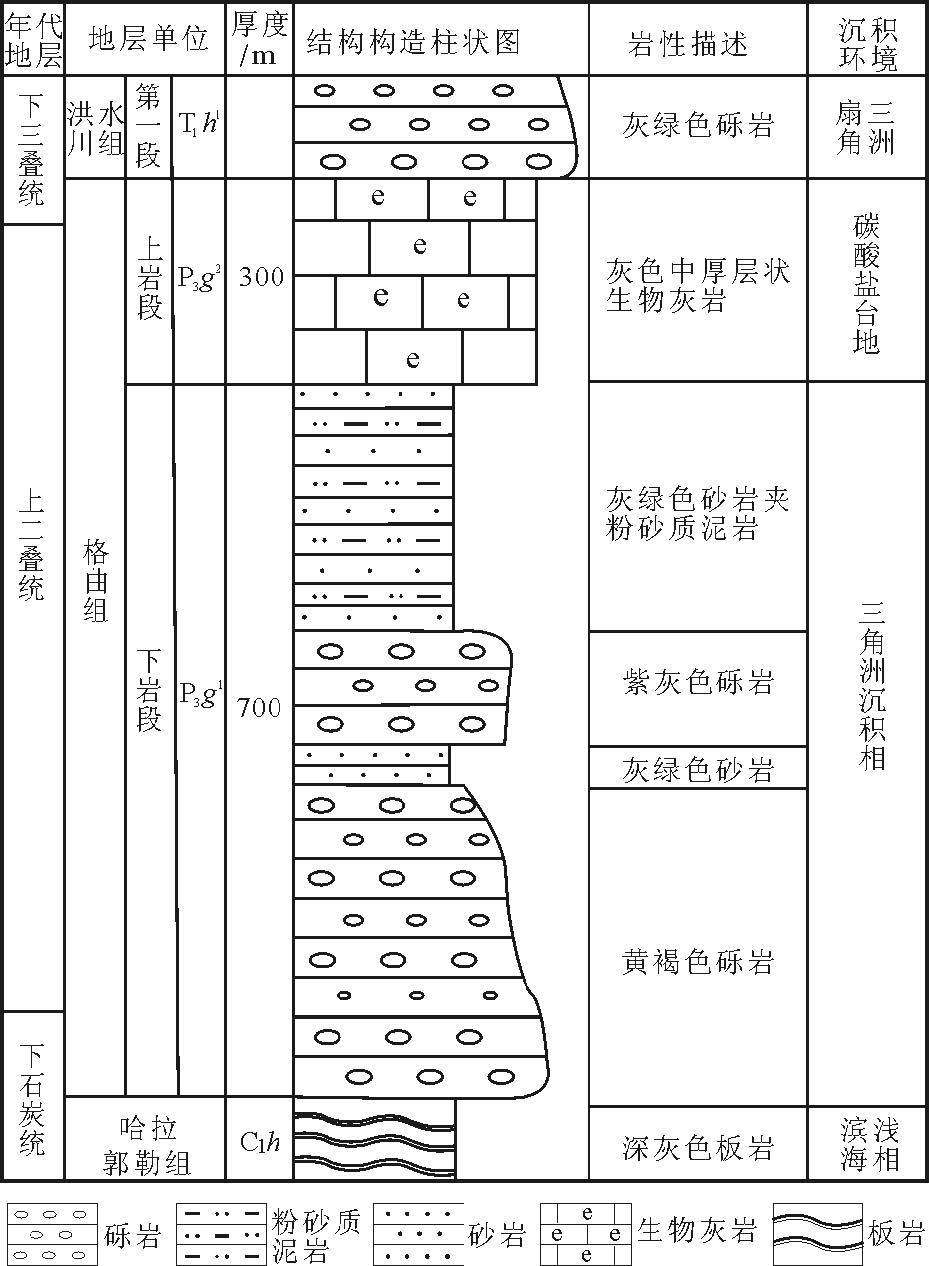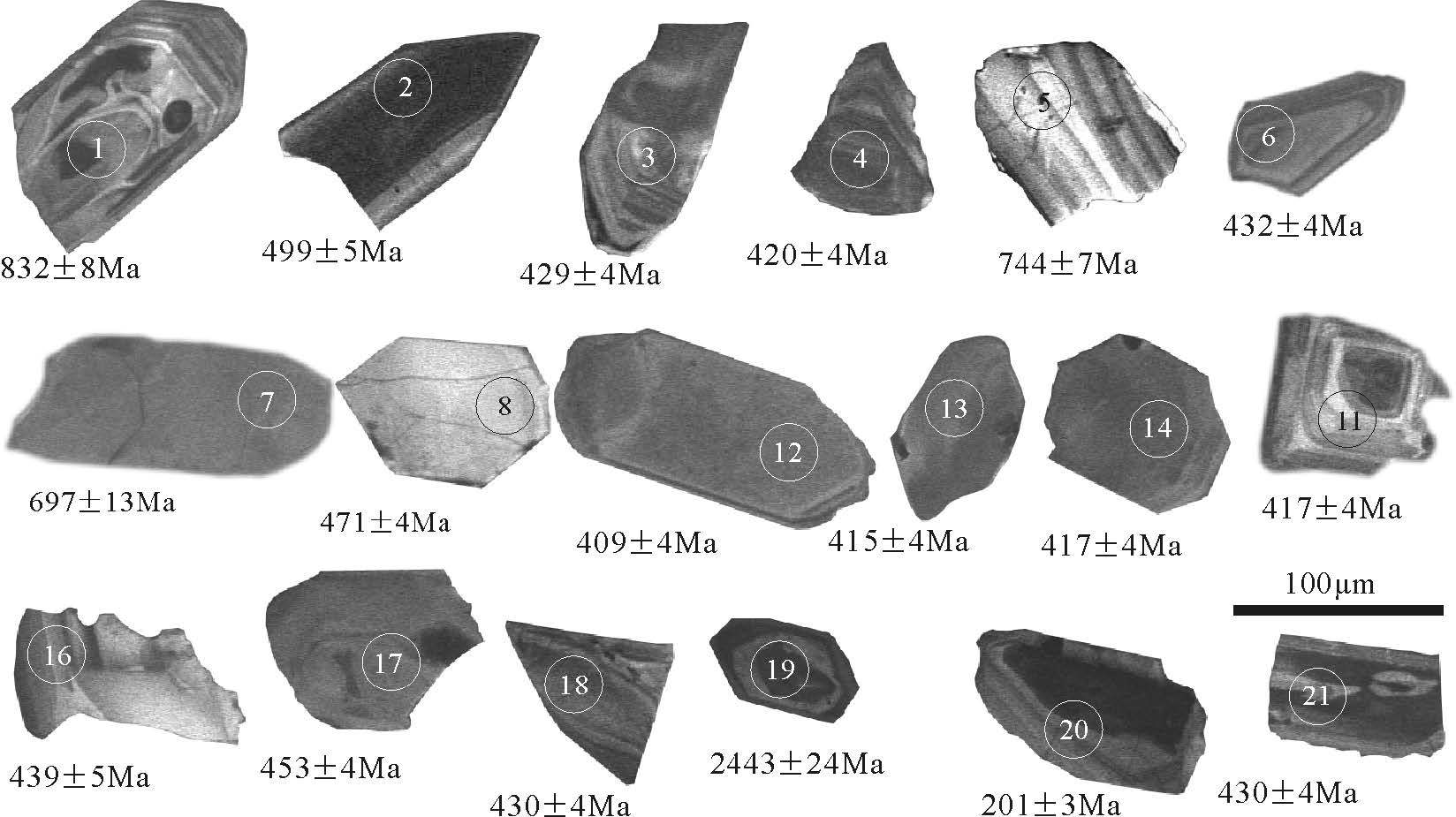Provenance analysis and structural implications of Gequ Formation at the Buqingshan area in the eastern segment of the East Kunlun region
-
摘要:
对东昆仑东段布青山得力斯坦地区出露的上二叠统格曲组砾岩层进行砾石成分、砾度统计及系统的LA-ICP-MS锆石UPb年龄谱分析。结果表明,格曲组砾岩层砾石成分以石英岩和花岗岩为主,硅质岩和基性岩次之,砂岩和灰岩较少,砾石的分散系数为1.54~2.02,该套砾岩为近源快速堆积的产物。砾岩碎屑锆石U-Pb年龄可分为3组:①早奥陶世-晚志留世年龄组为499~409Ma,峰值年龄为426Ma,对应早古生代末期原特提斯洋向北俯冲碰撞产生的一系列构造岩浆事件;②新元古代年龄组为744~619Ma,峰值年龄为744Ma,对应于全球Rodinia超大陆裂解事件;③古元古代年龄组为2443Ma,对应东昆仑地区古元古代构造岩浆热事件。结合碎屑锆石年龄及沉积学特征综合分析,花岗质砾石来源于北侧东昆仑造山带加里东期岩浆弧,沉积岩砾石则可能来自造山带早期的沉积地层,石英岩及其他变质岩砾石则多来自东昆仑基底变质岩系。综合判别,格曲组为一套沉积于活动大陆边缘环境的滨浅海相磨拉石建造,代表南侧古特提斯洋向北俯冲开始的构造阶段,是初始俯冲的沉积构造响应。
Abstract:Detailed statistics of gravel composition, gravel granulometry and the LA-ICP-MS U-Pb dating of detrital zircons from conglomerate bed in Delisitan of Buqingshan show that this conglomerate was derived from the nearby place with rapid accumulation. This conglomerate consists mainly of quartzite and granite and subordinately of siliceous rocks and basic rocks, with minor sandstone and limestone. The coefficients of dispersion are 1.54~2.02 for the gravel of conglomerate. The detrital zircon age spectra can be divided into three groups:①Early Ordovician-Late Silurian age group, 499~409Ma, with the peak value being 426Ma, corresponding to the tectono-magmatic events associated with Proto-Tethys northward subduction and collision at the end of Early Paleozoic; ②Neoproterozoic age group, 744~619Ma, with the peak value being 744Ma, corresponding to the breakup of Rodinia supercontinent; ③Paleoproterozoic age group, 2443Ma, corresponding to the tectono-magmatic hydrothermal event of East Kunlun in Paleoproterozoic. An integrated analysis of the U-Pb detrital zircon ages and sedimentology characteristics show that the granite gravel was derived from magmatic arc in Caledonian in northern East Kunlun Orogen, the gravel of quartzite and metamorphic rocks was from the East Kunlun metamorphic rock series in basement, and the gravel of sedimentary rocks might have come from the early sedimentary formation in the orogenic belt. A comprehensive analysis reveals that the Gequ Formation is a mollasse formation of the littoral-shallow facie which deposited on anactive continental margin. It represents both the beginning of the Paleo-Tethys northward subduction and the sedimentary responding of tectonics at the beginning of the subduction.
-
致谢: LA-ICP-MS 锆石U-Pb 测年过程中得到中国地质调查局天津地质矿产研究所工作人员的大力支持,野外工作和室内资料整理得到山西师范大学李小兵博士、中国煤炭地质局航测遥感局胡楠硕士、四川省核工业地质局281 大队刘图杰硕士等的帮助,在此一并表示感谢。
-
图 1 布青山-阿尼玛卿构造带地质简图(a)和布青山地区地质图(b)
1—第四系;2—新近系;3—三叠系;4—上二叠统格曲组;5—中下二叠统马尔争组;6—上石炭统- 中下二叠统树维门科组;7—石炭系;8—中元古界苦海岩群;9—海山灰岩;10—海山玄武岩; 11—中酸性火山熔岩;12—花岗闪长岩;13—石英闪长岩;14—玄武岩;15—辉长岩; 16—蛇纹岩;17—韧性剪切带;18—断层;19—推覆体;20—采样位置
Figure 1. Simplified geological map of the Buqingshan-A’nyemaqen orogenic belt (a) and geological map of the Buqingshan area (b)
表 1 布青山得力斯坦地区格曲组砾岩层砾性特征
Table 1 Gravel characteristics of conglomerate layer in Delisitan of Buqingshan area
测点编号 砾性/% 砾度/mm 花岗岩 石英岩 青灰色硅质岩 肉红色硅质岩 砂岩 灰岩 基性岩 其他变质岩 d d50 S 细砾/% 中砾/% 粗砾/% 1 9 33 29 8 7 3 8 3 20 11 1.54 95 4 1 2 20 47 8 3 3 1 14 4 30 21 2.02 75 25 0 3 21 37 10 11 1 1 17 2 28 22 1.73 99 1 0 4 26 15 15 21 1 1 19 2 23 13 1.56 94 4 2 表 2 布青山得利斯坦地区砾岩层LA-ICP-MS 碎屑锆石U-Th-Pb 同位素分析结果
Table 2 LA-ICP-MS U-Th-Pb data of detrital zircons from conglomerate layer in Delisitan of Buqingshan area
测点编号 含量/10-6 同位素比值 表面年龄/Ma Pb U Th/U 207Pb/206Pb 207Pb/235U 206Pb/238U 207Pb/206Pb 207Pb/235U 206Pb/238U 测值 1σ 测值 1σ 测值 1σ 测值 1σ 测值 1σ 测值 1σ 1 54 198 0.69 0.48 0.0069 9.1164 0.2691 0.1378 0.0013 4181 21 2350 69 832 8 2 91 1116 0.60 0.057 0.0008 0.6357 0.0175 0.0805 0.0007 502 30 500 14 499 5 3 17 239 0.88 0.056 0.0009 0.5276 0.0148 0.0688 0.0007 436 35 430 12 429 4 4 21 254 1.27 0.084 0.0017 0.5139 0.0151 0.0673 0.0006 1294 39 421 12 420 4 5 7 49 0.90 0.077 0.0021 1.2898 0.0456 0.1223 0.0011 1108 55 841 30 744 7 6 28 371 0.74 0.07 0.0016 0.5203 0.0165 0.0694 0.0006 924 48 425 13 432 4 7 55 481 0.33 0.067 0.0008 1.0582 0.0305 0.1142 0.0021 844 25 733 21 697 13 8 5 58 0.80 0.056 0.0018 0.5897 0.0228 0.0758 0.0007 468 69 471 18 471 4 9 17 210 0.89 0.056 0.0009 0.5599 0.0158 0.0725 0.0007 453 34 451 13 451 5 10 15 210 0.77 0.055 0.0009 0.5275 0.0148 0.068 0.0006 430 35 430 12 424 4 11 9 128 0.77 0.055 0.0013 0.4968 0.0171 0.0668 0.0006 401 54 410 14 417 4 12 18 263 0.71 0.055 0.0009 0.4986 0.0151 0.0655 0.0006 422 36 411 12 409 4 13 16 210 1.30 0.055 0.001 0.5007 0.0165 0.0666 0.0006 418 40 412 14 415 4 14 20 299 0.71 0.055 0.0009 0.4987 0.0172 0.0668 0.0007 409 38 411 14 417 4 15 35 478 1.54 0.054 0.001 0.4943 0.0187 0.0679 0.0007 388 42 408 15 424 4 16 9 115 1.19 0.066 0.0015 0.5269 0.0221 0.0704 0.0007 800 48 430 18 439 5 17 15 218 0.59 0.055 0.0011 0.5569 0.0224 0.0728 0.0007 430 43 449 18 453 4 18 19 282 0.90 0.056 0.001 0.532 0.0202 0.069 0.0007 449 42 433 16 430 4 19 233 510 0.06 0.159 0.0023 9.9042 0.3523 0.4523 0.005 2443 24 2426 86 2406 27 20 118 3304 0.72 0.142 0.0037 0.6172 0.024 0.0316 0.0006 2247 45 488 19 201 3 21 22 309 0.99 0.055 0.0012 0.5269 0.0213 0.069 0.0007 429 47 430 17 430 4 -
赵红格,刘池洋.物源分析方法及研究进展[J].沉积学报,2003,21(3):409-415. 裴先治,胡楠,刘成军,等.东昆仑南缘哥日卓托地区马尔争组砂岩碎屑组成、地球化学特征与物源分析[J].地质论评,2015,61(2):307-323. Dickinson W R,Suczek C A.Plate tectonics and sandstone compositions[J]. AAPG Bulletin,1979,63(12):2164-2182. Dickinson W R,Suczek C A.Plate tectonics and sandstone compositions[J]. AAPG Bulletin,1979,63(12):2164-2182.
Dickinson W R.Provenance of north American Phanerozoic sandstones in relation to tectonic setting[J]. Geological Society of America Bulletin,1983,94:222-235. Dickinson W R.Provenance of north American Phanerozoic sandstones in relation to tectonic setting[J]. Geological Society of America Bulletin,1983,94:222-235.
裴先治.勉略-阿尼玛卿构造带的形成演化与动力学特征[D].西北大学博士学位论文,2001:1-155. 裴先治,张国伟,赖绍聪,等.西秦岭南缘勉略构造带主要地质特征[J].地质通报,2002,21(8/9):484-494. 裴先治,李佐臣,李瑞保,等.祁连山造山带东段早古生代葫芦河群变质碎屑岩中碎屑锆石LA-ICP-MS U-Pb年龄:源区特征和沉积时代的限定[J].地学前缘,2012,19(5):205-224. 闫臻,Korchagin O A,李继亮,等.东昆仑早三叠世洪水川组的源区特征:来自碎屑组成、重矿物和岩石地球化学的证据[J].岩石学报,2012,24(5):1068-1078. Bruguier O.Lanceelot J R.U-Pb dating on single detrital zircon grains from the Triassic Songpan-Ganze flysch(central China):provenance and tectonic correlations[J]. Earth and Planetary Science Letters,1997,152:217-231. Bruguier O.Lanceelot J R.U-Pb dating on single detrital zircon grains from the Triassic Songpan-Ganze flysch(central China):provenance and tectonic correlations[J]. Earth and Planetary Science Letters,1997,152:217-231.
Carter A, Steve J M.Combined detrital-zircon fission-track and UPb dating:a new approach to understanding hinterland evolution[J]. Geology,1999,27(3):235-238. Carter A, Steve J M.Combined detrital-zircon fission-track and UPb dating:a new approach to understanding hinterland evolution[J]. Geology,1999,27(3):235-238.
闫义,林舸,李自安,等.利用锆石形态、成分组成及年龄分析进行沉积物源区示踪的研究[J].大地构造与成矿学,2003,27(2):184-190. 陆松年,陈志宏,相振群,等. 秦岭岩群副变质岩碎屑锆石年龄谱及其地质意义探讨[J]. 地学前缘,2006,13(6):303-310. 董春艳,李才,万渝生,等. 西藏羌塘龙木错-双湖缝合带南侧奥陶纪温泉石英岩碎屑锆石年龄分布模式:构造归属及物源区制约[J]. 中国科学(D辑),2011,41(3):299-308. 闫义,林舸,王岳军,等.盆地陆源碎屑沉积物对源区构造背景的指示意义[J].地球科学进展,2002,17(1):85-90. 刘战庆,裴先治,李瑞保,等.东昆仑南缘不青山构造混杂岩带早古生代白日切特中酸性岩浆活动:来自锆石U-Pb测年及岩石地球化学证据[J].中国地质,2011,38(5):1150-1167. 李瑞保.东昆仑造山带(东段)晚古生代-早中生代造山作用研究[D].长安大学博士学位论文,2012:1-173. 殷鸿福,张克信.东昆仑造山带的一些特点[J].地球科学,1997,4:339-3423. 李瑞保,裴先治,李佐臣,等.东昆仑东段晚古生代-中生代若干不整合面特征及其对重大构造事件的响应[J].地学前缘,2012,19(5):244-254. 孙雨,裴先治,丁仨平,等.东昆仑哈拉尕吐岩浆混合花岗岩:来自锆石U-Pb年代学的证据[J].地质学报,2009,83(7):1000-1010. 刘成东.东昆仑造山带东段花岗岩岩浆混合作用[M].北京:地质出版社,2008:1-142. 陈国超.东昆仑造山带(东段)晚古生代-早中生代花岗质岩石特征、成因及地质意义[D].长安大学硕士学位论文,2014:1-182. 陆松年,于海峰,赵凤清.青藏高原北部寒武纪地质初探[M].北京:地质出版社,2002:1-125. Yang J S,Robinson P T,Jiang C F,et al.Ophiolites of the Kunlun Mountains,China and their tectonic implications[J].Tectonophysics,1996,258:299-305. Yang J S,Robinson P T,Jiang C F,et al.Ophiolites of the Kunlun Mountains,China and their tectonic implications[J].Tectonophysics,1996,258:299-305.
刘战庆,裴先治,李瑞保,等.东昆仑南缘阿尼玛卿构造带布青山地区两期蛇绿岩的LA-ICP-MS锆石U-Pb定年及其构造意义[J].地质学报,2011,85(2):185-194. 冯建赟,裴先治,于书伦,等.东昆仑都兰可可沙地区镁铁-超镁铁质杂岩的发现及其LA-ICP-MS锆石U-Pb年龄[J].中国地质,2010,37(1):28-38. 冯建赟.东昆仑都兰可可沙-科科可特镁铁-超镁铁质岩的地质特征、形成时代及构造意义[D].长安大学硕士学位论文,2010:1-78. 张亚峰,裴先治,丁仨平,等.东昆仑都兰县可可沙地区加里东期石英闪长岩锆石LA-ICP-MS U-Pb年龄及其意义[J].地质通报,2010,29(1):79-85. 李王晔,李曙光,郭安林,等.青海省东昆南构造带苦海辉长岩和德尔尼闪长岩的锆石SHRIMP U-Pb年龄及痕量元素地球化学——对"祁-柴-昆"晚新元古代-早奥陶世多岛洋南界的制约[J].中国科学(D辑),2007,37:288-294. 崔美慧,孟繁聪,吴祥珂,等.东昆仑祁漫塔格早奥陶世岛弧:中基性火成岩地球化学、Sm-Nd同位素年代学证据[J].岩石学报, 2011,27(11):3365-3379. 陈有炘,裴先治,李瑞保,等.东昆仑东段纳赤台岩群火山岩锆石U-Pb年龄、地球化学特征及构造意义[J].地学前缘,2013,20(6):240-254. 高晓峰,校培喜,谢从瑞,等.东昆仑阿牙克木湖北巴什尔希花岗岩锆石LA-ICP-MS U-Pb定年及其地质意义[J].地质通报, 2010,29(7):1001-1008. 王晓霞,胡能高,王涛,等.柴达木盆地南缘晚奥陶世万宝沟花岗岩:锆石SHRIMP U-Pb年龄、Hf同位素和元素地球化学[J].岩石学报,2012,28(9):2950-2962. 刘彬,马昌前,蒋红安,等.东昆仑早古生代洋壳俯冲与碰撞造山作用的转换:来自胡晓钦镁铁质岩石的证据[J].岩石学报,2013, 29(6):2093-2106. 李瑞保,裴先治,李佐臣,等.东昆仑南缘布青山构造混杂带亿可哈拉尔花岗闪长岩年代学、地球化学特征及构造意义研究[J].地球学报,2014,35(4):434-444. Li R B,Pei X Z,Li Z C,et al.Regional Tectonic Transformations in East Kunlun Orogenic Belt in Early Paleozoic:Constraints from the Geochronology and Geochemistry of Helegananaren Alkalifeldspar Granite[J].Acta Geologica Sinica,2013,87(2):333-345. Li R B,Pei X Z,Li Z C,et al.Regional Tectonic Transformations in East Kunlun Orogenic Belt in Early Paleozoic:Constraints from the Geochronology and Geochemistry of Helegananaren Alkalifeldspar Granite[J].Acta Geologica Sinica,2013,87(2):333-345.
陈亮,孙勇,裴先治,等.德尔尼蛇绿岩40Ar/39Ar年龄:青藏高原最北端古特提斯洋盆存在和延展的证据[J].科学通报,2001,46(45):424-426. 杨经绥,王希斌,史仁灯,等.青藏高原北部东昆仑南缘德尔尼蛇绿岩:一个被肢解了的古特提斯洋壳[J].中国地质,2004,31(3):225-238. 杨仁超,李进步,樊爱萍,等.陆源沉积岩物源分析研究进展与发展趋势[J].沉积学报,2013,31(1):99-107. 周新峰,李继红,王帅,等.沉积物物源分析方法综述[J].地下水, 2013,35(1):107-108. 徐亚军,杜远生,杨江海.沉积物物源分析研究进展[J].地质科技情报,2007,26(3):26-32. 袁洪林, 吴福元, 高山. 东北地区新生代侵入体的锆石激光探针U-Pb年龄测定与稀土元素成分分析[J]. 科学通报, 2003, 48(14):1511-1521. Yuan H L,Gao S,Liu X M,et al.Accurate U-Pb age and trace element determinations of zircon by laster ablation-inductively coupled plasma-mass spectrometry[J].Geostandarda and Geoanalytical Research,2004,28(3):353-370. Yuan H L,Gao S,Liu X M,et al.Accurate U-Pb age and trace element determinations of zircon by laster ablation-inductively coupled plasma-mass spectrometry[J].Geostandarda and Geoanalytical Research,2004,28(3):353-370.
吴元保,郑永飞.锆石成因矿物学研究及其对U-Pb年龄解释的制约[J].科学通报,2004,49(16):1589-1065. Cawood P A,Nemchin A A.Paleogeographic development of the east Laurentian margin:Constraints from U-Pb dating of detrital zircons in the Newfoundland Appalachians[J].Geological Society of America Bulletin,2001,113(9):1234-1246. Cawood P A,Nemchin A A.Paleogeographic development of the east Laurentian margin:Constraints from U-Pb dating of detrital zircons in the Newfoundland Appalachians[J].Geological Society of America Bulletin,2001,113(9):1234-1246.
李任伟,万渝生,陈振宇,等.根据碎屑锆石SHRIMP U-Pb测年恢复早侏罗世大别造山带源区特征[J].中国科学(D辑),2004,34(4):320-328. Keay S,Steele D,Compston W. Identifying Granite Sources by SHRIMP U-Pb zircon Geochronology:An Application to the Lachlan Fold belt[J].Contrib. Mineral. Petrol.,1999,137:323-341. Keay S,Steele D,Compston W. Identifying Granite Sources by SHRIMP U-Pb zircon Geochronology:An Application to the Lachlan Fold belt[J].Contrib. Mineral. Petrol.,1999,137:323-341.
钟玉芳,马昌前,佘振兵.锆石地球化学特征及地质应用研究综述[J].地质科技情报,2006,25(1):27-40. 倪晋宇.东昆仑造山带二叠纪-三叠纪火山岩锆石U-Pb年龄与构造环境[D].中国地质科学院硕士学位论文,2010:1-58. 陆露,张延林,吴珍汉,等.东昆仑早古生代花岗岩U-Pb年龄及其地质意义[J].地球学报,2013,34(4):447-454. 龙晓平,金巍,葛文春,等.东昆仑金水口花岗岩体锆石U-Pb年代学及其地质意义[J].地球化学,2006,35(4):333-345. 谌宏伟,罗照华,莫宣学,等.东昆仑喀雅克登塔格杂岩体的SHRIMP年龄及其地质意义[J].岩石矿物学杂志,2006,25(1):25-32. 陈有炘,裴先治,李佐臣,等.东昆仑东段巴隆花岗质片麻岩年代学、地球化学特征及地质意义[J].岩石学报,2015,31(8):2230-2244. 陈能松,夏小平,李晓彦,等.柴北缘花岗片麻岩的岩浆作用计时和前寒武纪地壳增长的锆石U-Pb年龄和Hf同位素证据[J].岩石学报,2007,23(2):501-512. 陈能松,李晓彦,王新宇,等.柴达木盆地南缘昆北单元变质新元古代花岗岩锆石SHRIMP U-Pb年龄[J]. 地质通报,2006,25(11):1311-1314. 李怀坤,陆松年,王惠初,等.青海柴北缘新元古代超大陆裂解的地质记录——全吉群[J].地质调查与研究,2003,26(1):27-37. 任军虎,张琨,柳益群,等.东昆仑金水口南变余辉长岩地球化学及锆石定年[J].西北大学学报,2011,41(1):100-106. 杨经绥,史仁灯,吴才来,等.柴达木盆地北缘新元古代蛇绿岩的厘定——罗迪尼亚大陆裂解的证据?[J].地质通报,2004,23(9/10):892-898. 王国灿,魏启荣,贾春兴,等.关于东昆仑地区前寒武纪地质的几点认识[J].地质通报,2007,26(8):929-937. 王国灿,王青海,简平,等.东昆仑前寒武纪基底变质岩系的锆石SHRIMP年龄及其构造意义[J].地学前缘,2004,11(4):481-490. 任军虎,柳益群,周鼎武,等.东昆仑小庙基性岩脉地球化学及LA-ICP-MS锆石U-Pb定年[J].吉林大学学报,2010,40(4):859-868. 杨经绥,许志琴,李海兵.东昆仑阿尼玛卿地区古特提斯火山作用和板块构造体系[J].岩石矿物学杂志,2005, 24(5):369-380. 李荣社,计文化,赵振明,等.昆仑早古生代造山带研究进展[J].地质通报,2007, 26(4):373-381. 刘战庆.东昆仑南缘布青山构造混杂岩带地质特征及区域构造研究[D].长安大学硕士学位论文,2011:1-180. 胡楠.东昆仑南缘布青山地区马尔争组地质特征、物源分析与构造演化[D].长安大学硕士学位论文,2014:1-102. 胡楠,裴先治,李瑞保,等.东昆仑南缘布青山得力斯坦地区马尔争组物源分析及其构造背景研究[J].地质学报,2013, 87(11):1731-1747.




 下载:
下载:






